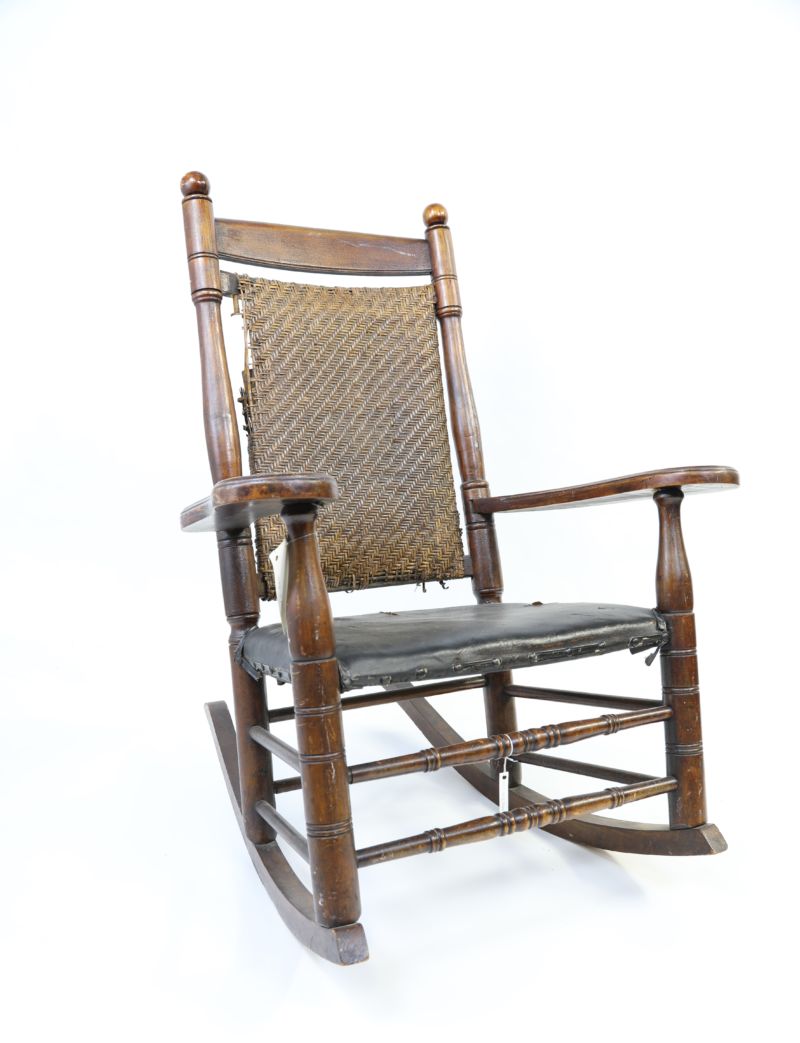April 18, 2017

This rocking chair, in the Hennepin History Museum Collection, was allegedly removed from the rooms of Harry Hayward after he was arrested for Kitty Ging’s murder
Above: this rocking chair, in the Hennepin History Museum Collection, was allegedly removed from the rooms of Harry Hayward after he was arrested for Kitty Ging’s murder
On the site of the new U.S. Bank Stadium, almost a hundred years before the Hubert H. Humphrey Metrodome was built, the old county courthouse and jail stood where the infamous Harry Hayward became the second to last person to be hanged in Minnesota in 1895 for his part in the murder of Catherine “Kitty” Ging. Harry Hayward was a professional gambler by trade, living in the Ozark Flats on 13th and Hennepin, a lovely stone building now known as the Bellevue which still stands today, the ground level home to Eli’s Food and Cocktails and Espresso Royale. Kitty Ging was a dressmaker who had moved to Minneapolis from New York City, and soon became privy to Hayward’s schemes. Unbeknownst to her, the caretaker of the Ozark Flats, Claus Blixt, would help Hayward take her life one fateful evening. Blixt, blackmailed by Hayward, shot Kitty in the back of the head in 1894 as they travelled by horse-drawn carriage near Lake Calhoun.
The brutal killing shocked the city. People could scarcely believe a handsome, wealthy, and charming man like Hayward had any part in it. Yet Hayward’s true character became rapidly clear. Harry’s brother Adry soon informed the sheriff that Harry had plotted to kill Kitty in order to collect money for a life insurance policy he had taken out after loaning her money. Harry’s other brother, Thaddeus, told reporters frankly that Harry had “a moral color blindness” and that Kitty’s murder was “a sort of a dream to him; he thinks it is a good joke.”
Minneapolis newspapers reported on the murder and trial incessantly, and conspiracy theories quickly began to arise. Rather than by using the power of manipulation, Hayward was said to have hypnotized Claus Blixt, into murdering Ging, and to have hypnotized Ging into helping him with his schemes. Rumors only continued with Harry’s death. Although witnesses watched him hang and were given sections of the noose as souvenirs, he was rumored to have survived due to his body being replaced with a goat. Even the dissection of his brain, which purported to prove his “dwarfed moral perceptions” as well as his lustful, cowardly nature, did not quell the rumors of his survival.
Even more recently, in the 1980s just a few years after the metrodome was built, Jim Klobuchar, father of Senator Amy Klobuchar, wrote that “disciples of the occult” suggested ghosts were responsible for a “chain of debacles” happening there. “I’m ready to nominate Harry Hayward’s ghost,” he speculated, “Harry was hanged for murder nearly 80 years ago, a few feet from where the left-field seats are today. We may still be paying for it.” In 2000, a tour highlighted the Bellevue, where a city councilmember hired a clairvoyant to discover whether the spirits of Kitty Ging or Claus Blixt had haunted the building. Due to its connection to the murder, the building today remains one of Minneapolis’s important sites for historic preservation.
Whether or not you believe in ghosts and stadium hauntings, the murder of Kitty Ging is remembered now as one of Minneapolis’s early tragic and sensational murders. The rumors surrounding the trial showed the disbelief of the public that someone could plot such a horrible crime in the Victorian age. Today, those rumors have turned to legend, and the presence of Ging and Hayward’s ghosts are still felt by some throughout the city. Whether you’re having a cup of coffee at Espresso Royale, or watching a game at the new stadium, remember this piece of Hennepin County history and be sure to let us know if you notice any hauntings.
Written by HHM intern Caitlin Crowley. Caitlin is a current Augsburg student where she is majoring in history with a Medieval History minor. She comes to HHM through the Minnesota Historical Society’s ACTC extern program.
Sources:
Adam Westford, Twin Citian, Harry Hayward file, Hennepin History Museum.
Billy B. Hoke, “Tittle-Tattle Tattle-Tale,” November 12, 1948, page 2
Jim Klobuchar, Star and Tribune, March 27, 1984.
“Justice Knots the Rope,” November 20, 1895, Harry Hayward Scrapbook #1 of 2, Hennepin History Museum.
Scott Russell, “Remembering Kitty Ging: Apartment linked to famous murder will be part of historic tour,” Southwest Journal, March 6-March 19, 2000.
“Shown By His Brain: A Specialist Makes Deductions from Hayward’s Gray Matter: Moral Perception Dwarfed.” Harry Hayward Trial Newspaper Clippings, Harry Hayward Scrapbook #1 of 2, Hennepin History Museum.
Walter Ewert, “Historians Get Clippings of Hayward Murder Trial,” Harry Hayward file, Hennepin History Museum.
William Johnson, “65 Years Ago Harry Hayward Laughingly Met a Slayer’s Fate,” Sun Tribune, December 11, 1960.
